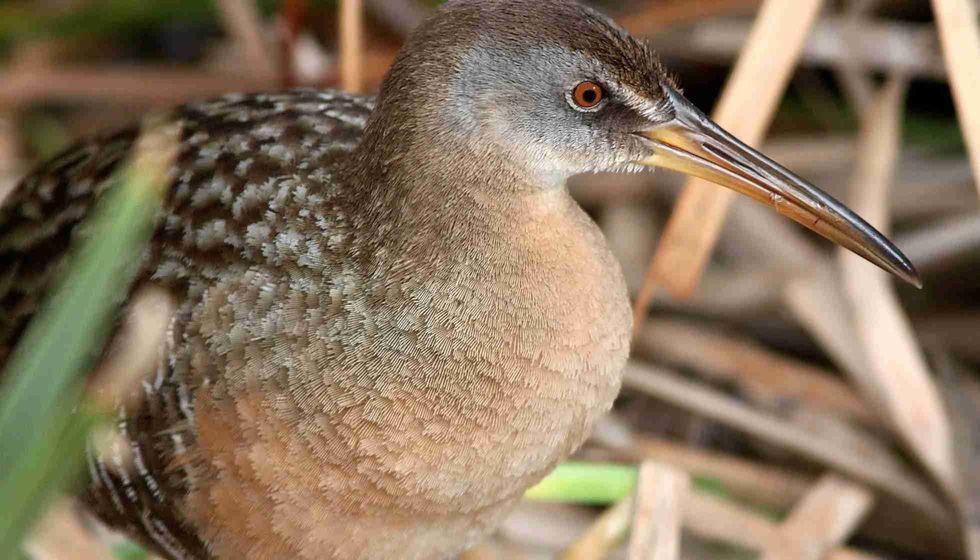The clapper rail (Rallus crepitans) is a species of bird found in South America, the Atlantic Coast, Texas, and the Caribbean Islands. According to the description given in reports, they prefer to live in saltwater marshes or mangrove marshes and wetlands situated in coastal regions which are rich in vegetation like cordgrass and pickleweed.
It is a chicken-like bird with a short tail and a slightly curved bill. Their plumage can vary from gray to a cinnamon color based on their location. These rails also interbreed with other rails when they share their territories, so it is often difficult to partake in their taxology.
Here, we have many amazing and interesting facts about clapped rail that you will enjoy. Let's take a look at these facts and information, and if you enjoy these then do read our golden pheasant facts and secretary bird facts.
Clapper Rail Interesting Facts
What type of animal is a clapper rail?
A clapper rail (Rallus crepitans) is a species of bird commonly found in South America, Central America, and the Caribbean.
What class of animal does a clapper rail belong to?
The clapper rail bird belongs to class Aves.
How many clapper rails are there in the world?
The total population of clapper rails is unknown and is hard to estimate due to outdated surveys. While the North American Birds' Survey suggests that their population has decreased between 1966 to 2015 and was considered Endangered, it is not even present on the 2016 State Of North America's Birds Watch List.
Where does a clapper rail live?
Clapper rails prefer saltwater marsh and coastal wetlands, which are rich in vegetation and can be used as a refuge during the high tides. They are commonly found in South America, the Gulf Coast of Mexico, the Atlantic Coast, and the Caribbean islands.
What is a clapper rails' habitat?
A clapper rail lives in saltwater marshes and coastal wetlands full of cordgrass, mangroves, and other types of vegetation.
Who do clapper rails live with?
Clapper rails are monogamous during the breeding season and form pairs to perform nesting and breeding. They sometimes form loose colonies during the breeding season, mainly because of the availability of their preferred habitat.
How long does a clapper rail live?
Clapper rails live for around seven and a half years in the wild. This also depends on climate change as well as the availability of a habitat rich in vegetation.
How do they reproduce?
During the breeding season, the male clapper railbird approaches the female, points down his bill, and nods his head from left to right. They form a nest in a higher location to avoid the danger of flooding and lower places with tall grasses and dense cover to hide the nest from predators.
These nests are tall to avoid flooding and are well-camouflaged and built by the male. He also creates a dome to cover the nest and keep it hidden and makes ramps for entry and exit.
Females lay up to 12 eggs and both the sexes perform the incubation process. Hatching takes place after 20-23 days, and both the parents feed and take care of the young hatchling. After ten weeks of hatching, the young can fly by themselves without any problems.
What is their conservation status?
The conservation status of clapper rails is of Least Concern according to the IUCN, though it is hard to determine their population due to the change in information every time a long-term survey is performed.
For example, the North American Birds' Survey suggests that their population has decreased between 1966 to 2015, but now they come under the category of Least Concern, meaning that their population is stable and out of danger.
Clapper Rail Fun Facts
What do clapper rails look like?

Clapper rails have a gray and brown body with a chestnut breast. It has a chicken-like marsh body and prefers walking instead of flying.
It has a white patch under its short tail, its wings are in a round shape, and its bill is slightly curved downwards. Both the sexes have similar plumage, but one difference between them is that the male is a bit larger than the female.
How cute are they?
They are small and cute and do no harm to humans unless they enter their territory or tease them and make them feel threatened.
How do they communicate?
Clapper rails are loud birds, and like other birds, they also use call notes to communicate with or alert other birds. A clapper rail sound goes like 'kek-kek-kek', which is quite loud and harsh. This is made to alert others about the presence of any other species of bird or predator.
How big is a clapper rail?
According to the description given in many reports, they are 12.6-16.1 in (32-41 cm) in length. Their body is similar to that of a chicken, but they are smaller than chickens. Yuma clapper rail is the largest among them and can grow up to 16.1 in (40.8 cm) in length.
How fast can a clapper rail fly?
Unlike other birds, clapper rails do not fly. They prefer to walk instead. They walk with their neck outstretched and their tails erect. They might jerk up and down if flustered.
How much does a clapper rail weigh?
An adult clapper rail weighs around 9.2-14.1 oz (260-400 g). They are small and light birds that are widely spread among the United States. They can be found in Texas, California, the Gulf of Mexico, and the Caribbean.
What are the male and female names of the species?
The male and the female of the species do not have separate names.
What would you call a baby clapper rail?
A baby clapper rail does not have a unique name. They are called chicks. Clapper rail chicks learn to fly nine to ten weeks after hatching.
What do they eat?
They are omnivores who eat both plants as well as other animals. They prey on crabs, fish, eggs, and seeds. During the winter, their diet mainly consists of seeds and vegetation. Their favorite food includes fiddler crabs.
Are they aggressive?
They are not aggressive, and their first response is to run away if they feel threatened or when they see a predator. If cornered, they might turn aggressive and can attack back at you or any other animal to save themselves.
Would they make a good pet?
They are not suitable to be kept as pets as they are wild animals.
Did you know...
The clapper rail is very similar to the king rail in appearance. They both have greyish-brown plumage. If we had to make a king rail vs clapper rail comparison, we'd find out that the basic difference is that king rail is brighter in color while clapper rail is duller.
Other species of clapper rail birds are the California clapper rail, light-footed clapper rail, and Yuma clapper rail.
Light-footed clapper rails are found exclusively on the California coastline from Santa Barbara to the California-Mexico border and into northern Baja California, Mexico. These birds have been considered to be Endangered as only around 600 of them are alive in the world right now.
Californian clapper rails are found in the southern parts of San Francisco, Texas, in marshlands that have thick vegetation filled with cordgrass, mangrove, and pickleweed.
Sometimes they split their territory with other species of clapper rails.
Do clapper rails migrate?
Clapper rails are found in Southern and Central America and along the Gulf of Mexico. They migrate for a short distance during winters when they fly towards the southern parts of the coast.
When did the clapper rail become endangered?
Clapper rails have the conservation status of Least Concern while a few of its sub-species have the status of Endangered. One of these species is the light-footed clapper rails that were listed as Endangered in 1970 for the first time.
It has been estimated that there are fewer than 600 of them left in the wild because of the degradation of their marshes and habitat loss in general. The California clapper rails are also Endangered.
Here at Kidadl, we have carefully created lots of interesting family-friendly animal facts for everyone to discover! Learn more about some other birds, including horned lark facts and cliff swallow facts.
You can even occupy yourself at home by coloring in one of our free printable Clapper rail coloring pages.









